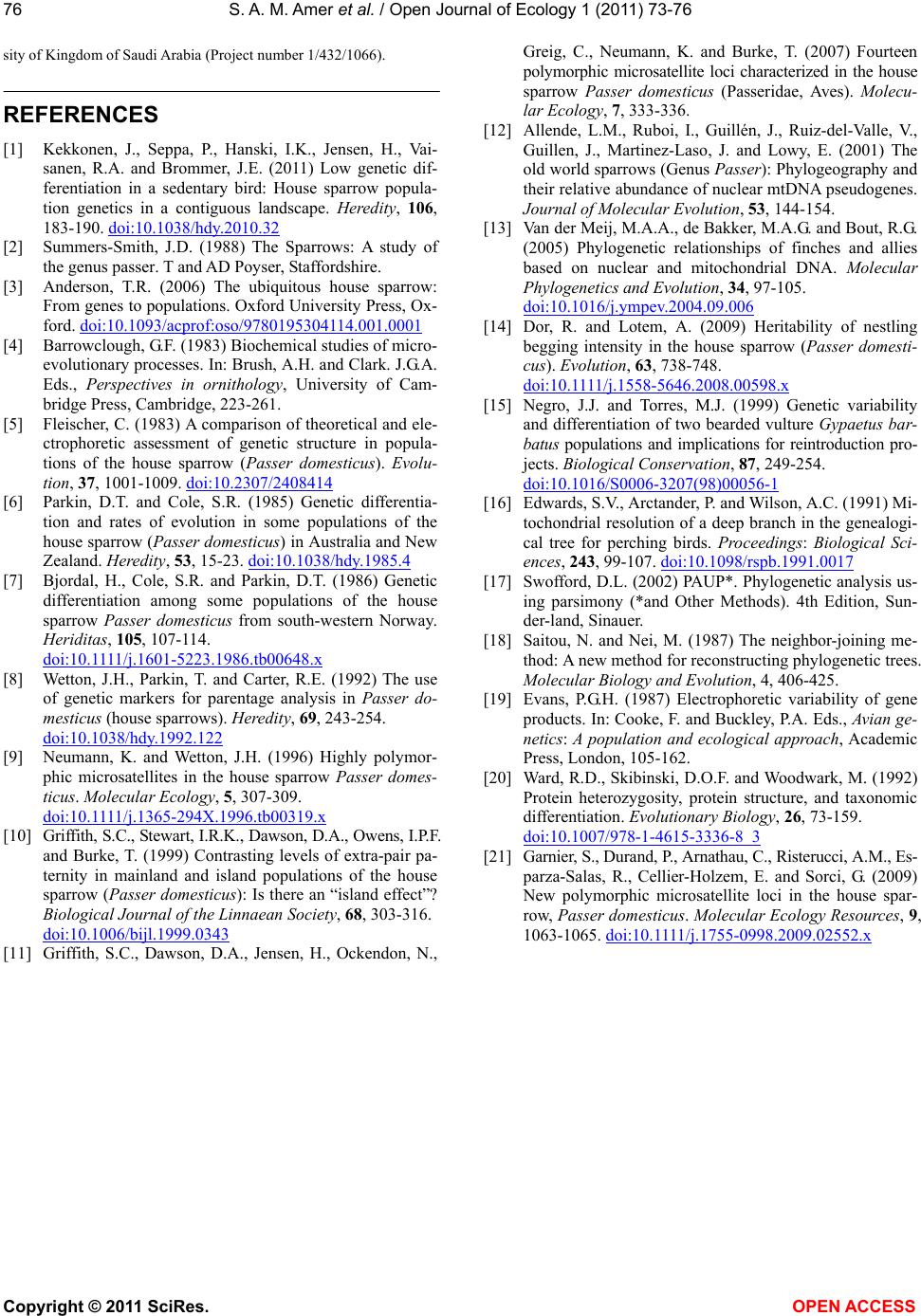
S. A. M. Amer et al. / Open Journal of Ecology 1 (2011) 73-7 6
Copyright © 2011 SciRes.
76
sity of Kingdom of Saudi Arabia (Project number 1/432/1066).
OPEN ACCESS
REFERENCES
[1] Kekkonen, J., Seppa, P., Hanski, I.K., Jensen, H., Vai-
sanen, R.A. and Brommer, J.E. (2011) Low genetic dif-
ferentiation in a sedentary bird: House sparrow popula-
tion genetics in a contiguous landscape. Heredity, 106,
183-190. doi:10.1038/hdy.2010.32
[2] Summers-Smith, J.D. (1988) The Sparrows: A study of
the genus passer. T and AD Poyser, Staffordshire.
[3] Anderson, T.R. (2006) The ubiquitous house sparrow:
From genes to populations. Oxford University Press, Ox-
ford. doi:10.1093/acprof:oso/9780195304114.001.0001
[4] Barrowclough, G.F. (1983) Biochemical studies of micro-
evolut ionary proc esses. In: Bru sh, A.H. a nd Clar k. J.G.A.
Eds., Perspectives in ornithology, University of Cam-
bridge Press, Cambridge, 223-261.
[5] Fleischer, C. (1983) A comparison of theoretical and ele-
ctrophoretic assessment of genetic structure in popula-
tions of the house sparrow (Passer domesticus). Evolu-
tion, 37, 1001-1009. doi:10.2307/2408414
[6] Parkin, D.T. and Cole, S.R. (1985) Genetic differentia-
tion and rates of evolution in some populations of the
house sparrow (Passer domesticus) in Australia and New
Zealand. Heredity, 53, 15-23. doi:10.1038/hdy.1985.4
[7] Bjordal, H., Cole, S.R. and Parkin, D.T. (1986) Genetic
differentiation among some populations of the house
sparrow Passer domesticus from south-western Norway.
Heriditas, 105, 107-114.
d oi :1 0.1111 /j .1 601 -5223.1986.tb00648.x
[8] Wetton, J.H., Parkin, T. and Carter, R.E. (1992) The use
of genetic markers for parentage analysis in Passer do-
mesticus (house sparrows). Heredity, 69, 243-254.
doi:10.1038/hdy.1992.122
[9] Neumann, K. and Wetton, J.H. (1996) Highly polymor-
phic microsatellites in the house sparrow Passer domes-
ticus. Molecular Ecology, 5, 307-309.
d oi :1 0.1111 /j .1 365 -294X.1996.tb00319.x
[10] Griffith, S.C., Stewart, I.R.K., Dawson, D.A., Owens, I.P.F.
and Burke, T. (1999) Contrasting levels of extra-pair pa-
ternity in mainland and island populations of the house
sparrow (Passer domesticus): Is there an “island effect”?
Biological Journal of the Linnaean Society, 68, 303-316.
doi:10.1006/bijl.1999.0343
[11] Griffith, S.C., Dawson, D.A., Jensen, H., Ockendon, N.,
Greig, C., Neumann, K. and Burke, T. (2007) Fourteen
polymorphic microsatellite loci characterized in the house
sparrow Passer domesticus (Passeridae, Aves). Molecu-
lar Ecology, 7, 333-336.
[12] Allende, L.M., Ruboi, I., Guillén, J., Ruiz-del-Valle, V.,
Guillen, J., Martinez-Laso, J. and Lowy, E. (2001) The
old world sparrows (Genus Passer): Phylogeography and
their relative abundance of nuclear mtDNA pseudogenes.
Journal of Molecular Evolution, 53, 144-154.
[13] Va n der Meij, M.A.A., de Bakker, M.A.G. and Bout, R.G.
(2005) Phylogenetic relationships of finches and allies
based on nuclear and mitochondrial DNA. Molecular
Phylogenetics and Evolution, 34, 97-105.
doi:10.1016/j.ympev.2004.09.006
[14] Dor, R. and Lotem, A. (2009) Heritability of nestling
begging intensity in the house sparrow (Passer domesti-
cus). Evolution, 63, 738-748.
d oi :1 0.1111 /j .1 558 -5646.2008.00598.x
[15] Negro, J.J. and Torres, M.J. (1999) Genetic variability
and differentiation of two bearded vulture Gypaetus bar-
batus populations and implications for reintroduction pro-
jects. Biological Conservation, 87, 249-254.
doi:10.1016/S0006-3207(98)00056-1
[16] Edwards, S.V. , Arctander, P. and Wilson, A.C. (1991) Mi-
tochondrial resolution of a deep branch in the genealogi-
cal tree for perching birds. Proceedings: Biological Sci-
ences, 243, 99-107. doi:10.1098/rspb.1991.0017
[17] Swofford, D.L. (2002) PAUP*. Phylogenetic analysis us-
ing parsimony (*and Other Methods). 4th Edition, Sun-
der-land, Sinauer.
[18] Saitou, N. and Nei, M. (1987) The neighbor-joining me-
thod: A new method for reconstructing phylogenetic trees.
Molecular Biology and Evolution, 4, 406-425.
[19] Evans, P.G.H. (1987) Electrophoretic variability of gene
products. In: Cooke, F. and Buckley, P.A. Eds., Av ian ge -
netics: A population and ecological approach, Academic
Press, London, 105-162.
[20] Ward, R.D., Skibinski, D.O.F. and Woodwark, M. (1992)
Protein heterozygosity, protein structure, and taxonomic
differentiation. Evolutionary Biology, 26, 73-159.
doi:10.1007/978-1-4615-3336-8_3
[21] Garnier, S., Durand, P., Arnathau, C., Risterucci, A.M., Es-
parza-Salas, R., Cellier-Holzem, E. and Sorci, G. (2009)
New polymorphic microsatellite loci in the house spar-
row, Passer dome sticus. Molecular Ecology Resources, 9,
1063-1065. d oi :10 .1111 /j. 1755-0998.2009.02552.x